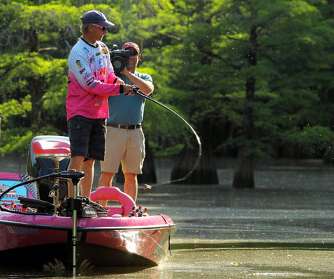
This year’s Bassmaster Classic on the Lousiana Delta wasn’t much help to custom lure painters. Much of the television coverage showed top finishers Kevin VanDam, Aaron Martens and Scott Rook fishing side-by-side throwing not only the exact same model square bill, but also the same color. And it wasn’t anything exotic – just chartreuse with a black back and a bit of orange on the throat. That paint job might even predate James Heddon himself.
But if you think that you can go out with nothing but chartreuse/black, sexy shad, Tennessee shad and red craw in the boat, you may be missing out on some deadly baits – even if you wouldn’t be caught dead buying them in front of your friends.
One is all-black, or black and blue. According to Clark Reehm, this pattern is a big deal on the Arkansas River, where a black crank can catch fish when nothing else will. Kevin Short, a noted Arkansas River expert, doesn’t just limit it to that one body of water.
“I got started on it years ago, fishing a black Bill Norman Middle N on rocks on the river,” Short said. “I was in a backwater area and I knew there were fish up against wood but they wouldn’t eat. I took a Zoom WEC E1 and a black magic marker and colored everything except its yellow eyes, figuring the bass could see it better. When you can’t seem to get anything going, it’s deadly.”
Ish Monroe doted on a black and blue crankbait when he was dominating trails on the California Delta. He started off with an Arbogast Mud Bug in that pattern, and “was catching way more than anyone else, especially early in the season when the water was dirtier.” He got away from it when he first went national, but gradually drifted back. First he got some Wiggle Warts painted black for the Ozarks lakes, but since then one of his favorites has been a Norman crankbait in solid black with blue glitter. “I just crush them on that at Wheeler in the early season,” he said. “It doesn’t resemble anything. But when you think about it, a black and blue jig is always good. So is a big black spinnerbait slow rolled.”
On the other end of the spectrum, Short also likes a Norman in pink. That should come as no surprise, since it has become his signature color. “Norman color number 165,” he said. “Actually, they call it red and white, but I tell you, the thing is pink.
“It’s pretty godawful, but it’s deadly in muddy water,” he continued. “If people ask you what you caught them on and you say a pink and white crankbait, they’re like, ‘Yeah, right.’ Most of the time I throw it in the spring because that’s when we have the dirtiest water, but I’ve also done well on it in the fall.”
Once again, Short isn’t the only devotee of this oddball paint job. Oklahoma pro Kenyon Hill relies on it in dirty water as well, especially with a warp speed retrieve. “I like to fish it fast, to trigger a reaction bite,” he said.
If a particular paint job can make a crankbait effective, do two double your chances? Several Elite Series pros said they like cranks that look different depending on which side you approach from. Both Pete Ponds and Matt Herren like a Bandit 200 in the “Mistake” pattern, red with black bars on one side and chartreuse with black bars on the other. Once again, it’s deadly in off-colored water, combining two of the most popular spring combinations into a single package. Bill Lowen takes it one step further. Raised on the Ohio River where all manner of garage-manufactured diving plugs come into play, Lowen has been hand-foiling cranks for years. One of his favorites has silver on one side and gold on the other. “It gives you a different look in the water,” he said. “Like a spinnerbait with gold and silver blades.”
The manufacturers of black and chartreuse paint aren’t going to starve any time soon, and top selling patterns earned those positions because they work. But, once in a while, it pays to go against the grain when selecting crankbait colors.





